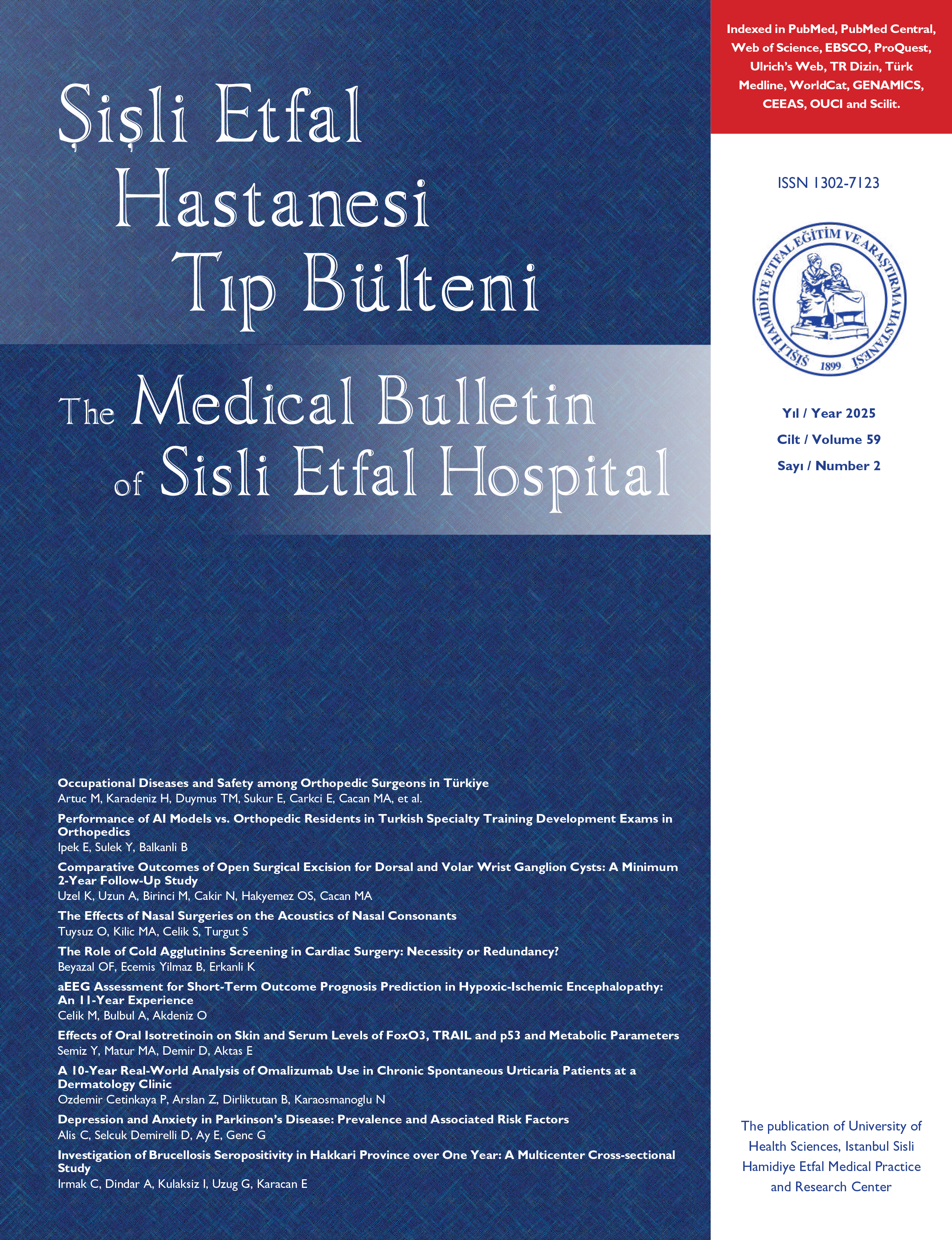
Alt konka hipertofisinin alerjik ve non-alerjik rinitli hastalarda radyofrekans ile ablasyonunun sonuçları
Bilge Türk, Arzu Yasemin Korkut, Kerem Sami Kaya, Egehan Salepçi, Özlem Ünsal, Berna Uslu Coşkun, Suat TurgutŞişli Hamidiye Etfal Training and Research Hospital, Otorhinolaryngology Head and Neck Surgery, Şişli, İstanbul, TurkeyAmaç: Medikal tedaviye cevap vermeyen alt konka hipertofisi tedavisinde radyofrekans ile konka cerrahisi yaygın olarak kullanılan bir metoddur. Bu çalışmanın amacı konka hipertrofisi tedavisinde radyofrekans ablasyonu ile konka cerrahisinin etkinliğini değerlendirmek ve alerjik ve non-alerjik rinitli hastalardaki sonuçlarını karşılaştırmaktır.
Method: Bu prospektif randomize olmayan klinik çalışmaya üçüncü basamak hastanemizde Eylül 2017 ve Ocak 2018 tarihleri arasında alt konkalarına radyofrekans işlemi uygulanan yaşları 18 ve 67 arasında değişen (ortalama 37 ± 13) 59 hasta dahil edildi. Alerjik rinitli hastalar (n=23) grup 1, non-alerjik hastalar (n=36) grup 2 olarak sınıflandırıldılar. Preoperatif ve postoperative üçüncü ve altıncı aylarda endoskopik burun muayeneleri ve akustik rinomanometri testleri uygulandı. Nazal semptomlar standart 0-10 vizüel analog skalası (VAS) ile değerlendirildi.
Bulgular: Her iki grupta da nazal tıkanıklıkta postoperative anlamlı derecede azalma olduğu ve bu azalmanın 1. grupta daha iyi olduğu görüldü. Kaşıntı, rinore ve hapşırma VAS skorlarındaki azalma grup 1 de istatiksel olarak anlamlı bulunurken, 2.grupta hapşırma VAS skorunda azalma anlamlı idi.
Sonuç: Bu çalışma radyofrekansın alt konka hipertofisi olan alerjik ve non-alerjik rinitli hastalarda etkili ve güvenli bir tedavi seçeneği olduğunu göstermiştir. Ayrıca alerjik rinitli hastalarda tüm nazal semptomların, non-alerjik rinitli hastalarda burun tıkanıklığı ve hapşırma semptomlarının daha iyi olmasını sağlamıştır.
Results of Radiofrequency Ablation of Inferior Turbinate Hypertrophy in Patients with Allergic and Non-Allergic Rhinitis
Bilge Türk, Arzu Yasemin Korkut, Kerem Sami Kaya, Egehan Salepçi, Özlem Ünsal, Berna Uslu Coşkun, Suat TurgutDepartment of Otorhinolaryngology Head and Neck Surgery, Şişli Hamidiye Etfal Training and Research Hospital, İstanbul, TurkeyObjectives: For the treatment of the inferior turbinate hypertrophy that is unresponsive to medical treatment, turbinate surgery with radiofrequency is a widely used method. This study aims to evaluate the efficacy of turbinate surgery with radiofrequency ablation for the treatment of turbinate hypertrophy, and compare the results of patients with allergic rhinitis and non-allergic rhinitis.
Methods: A total of 59 consecutive patients aged 1867 years (mean 37±13) who underwent radiofrequency ablation to the inferior turbinate at our tertiary care hospital from September 2017 to January 2018 were enrolled in this prospective nonrandomized clinical study. The patients with allergic rhinitis (n=23) were classed as group 1, and the patients with non-allergic rhinitis (n=36) were classed as group 2. Endoscopic nasal examination and an acoustic rhinometer were applied, and a standard 010 visual analog scale (VAS) was used to assess nasal symptoms preoperatively and postoperatively at the third and sixth months.
Results: The study found a significant reduction in nasal obstruction for both groups postoperatively. This reduction was higher in group 1. The decrease in nasal VAS scores for itching, rhinorrhea, and sneezing were statistically significant in group 1, whereas the decrease in nasal VAS scores for sneezing was significant in group 2.
Conclusion: This study demonstrates that radiofrequency appears to be an effective and safe treatment option for inferior turbinate hypertrophy of patients with allergic rhinitis or non-allergic rhinitis. It also provides a better perception of all nasal symptoms in patients with allergic rhinitis, and a better perception of nasal obstruction and sneezing in patients with non-allergic rhinitis.
Makale Dili: İngilizce



















